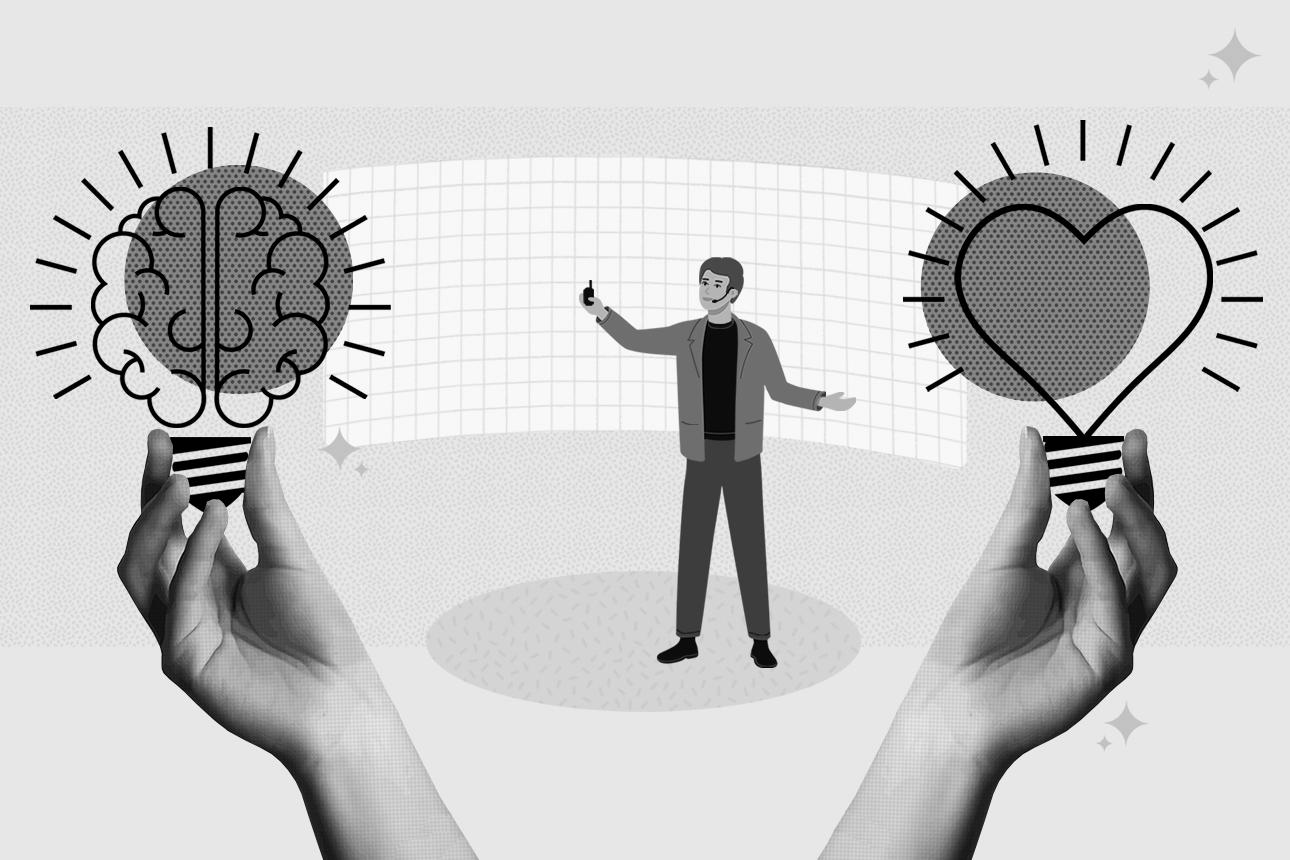Topics
Column
Our expert columnists offer opinion and analysis on important issues facing modern businesses and managers.
More in this series
Carolyn Geason-Beissel/MIT SMR | Getty Images
When you have the opportunity to connect with an audience, stating fact after fact is not the way to go. You have an opportunity to connect more deeply than you can with just facts. Granted, some presentations are solely to convey updated information. But if that’s the case, you’re probably better off just emailing the particulars and saving everyone time. The best use of a presentation is to motivate others.
Staying flat and factual can work in a scientific report setting, but it won’t help motivate most audiences. Facts alone don’t help audience members understand why the information is important: You’re possibly relying too heavily on attendees to surmise the meaning behind them and make connections between point A and point B. You’re making the audience work way too hard to identify the decision you’re hoping to persuade them to make.
Get Updates on Transformative Leadership
Evidence-based resources that can help you lead your team more effectively, delivered to your inbox monthly.
Please enter a valid email address
Thank you for signing up
Using emotion is a way to bring emphasis to the details and help them stand out. You want to complement facts with a pinch of content that will help the audience understand the value of the data and the valuable outcomes if it’s acted upon — or the consequences of it being ignored.
But if you had an audience of, say, biotech engineers, and you pulled the emotional strings too hard, that would be a huge mistake. And if you had a sales team you were trying to pump up, and you went full-on data, that would also be a mistake. You need to empathetically think about what’s going to be the right amount of emotional appeal and the right amount of intellectual appeal for your audience before your presentation. You need to blend your content the right way, almost like a recipe. You need balance.
Credibility plays a crucial role in this balancing act. By demonstrating that you have an understanding of the audience’s preferences and needs, you’re establishing common ground, and that reinforces your reliability. Your established trustworthiness and expertise provide a solid foundation that amplifies the impact of your presentation.
This isn’t a new idea. Back in the fourth century B.C., the Greek philosopher Aristotle claimed that to persuade, one must employ three types of argument:
- Logos, or logical appeal, where the speaker provides evidence through words and data.
- Pathos, or emotional appeal, where the speaker stirs the emotions and imaginations of audience members.
- Ethos, or ethical appeal, where the speaker leans into their existing credibility and character.
Aristotle’s rhetorical appeals are still relevant today. What’s key for managers, and often quite difficult, is knowing how to balance these appeals to an audience. Whether you’re presenting to a room full of engineers, a group of potential investors, or your colleagues and peers, the ability to calculate the right level of logic and emotion — in a way that resonates with the audience’s roles, industries, and problems — is a profoundly useful skill.
First, Understand Your Audience
The first step in reaching for this balance is understanding your audience members. Are they data-driven decision makers who thrive on statistics and factual evidence? Or are they more likely to be swayed by personal stories and emotional connections? The industry, department, and roles of your audience members may help you define the ratio of analytical to emotional content to aim for as you engage them. If you don’t take time to understand your audience, you risk creating an imbalance. What’s more, when you show up with emotional or analytical energy that doesn’t match the audience’s, it hurts your credibility. (See “An Analytical and Emotional Balance That’s Just Right.”)
When presenting to analytical audiences, you want to pull back on how much you apply an emotional appeal. Use it lightly and with intention. Heavily analytical folks are still human, so it can be motivating to include material in a presentation that shows, for example, how lives will be changed if people take action from the data presented.
For more emotionally driven audiences or emotionally charged content, you want to pull back on the analytical appeal. Allow the audience to become immersed in all the feels. Emotionally driven audiences don’t enjoy the overuse of facts and details. They want to know that data has been carefully considered, but they likely won’t want to see 20 slides with charts.
The right balance is key. Even if you’re the most remarkable presenter in the world, being too geeky or too expressive in your storytelling can create a chasm between you and the audience.
For example, it’s easy for many of us to get caught up in numbers. To be successful in most jobs, we work with data, charts, graphs, timelines, and dashboards all the time. But when launching a revolutionary new product, it’d be unwise to overwhelm an audience with too many figures. While analytical content is essential, it should always be presented in a digestible and engaging manner.
Facts and Feelings: The Perfect Blend for Persuasive Presentations
To address both the mind and the heart, you must create a compelling narrative that is both persuasive and memorable. To do this, step back and inventory your slides to identify any content that can be made either more analytical or more emotional. Think about what balance you’re aiming for overall. Change the tone and content of slides where appropriate; for example, a slide with statistical data can be followed by a slide with a powerful quote or a compelling image.
Examples of typical types of analytical content include statistical data and facts; charts, graphs, and visual data; quotations from experts; logical arguments and reasoning; citations from research and studies; diagrams and explanatory videos; demonstrations and specimens; and appendices with documentation.
Examples of typical types of emotional content include anecdotes and stories; humor; emotive exclamations, like “This is amazing”; evocative photos and illustrations; metaphors and similes; suspenseful reveals and bold statements; dramatic music and sound effects; dramatizations and physical props; and rewards, benefits, and offers.
Whether you’re tilting to the head or the heart, you need to connect with the audience on a personal level.
Of course, analytics and emotions often can be blended for impact. You can attach data to anecdotes or tell stories about the people who generated the logical arguments to humanize your message. Charts and graphs can be designed to evoke emotion — for example, a chart can be revealed gradually, bar by bar, to create suspense and keep the audience invested in your narrative, and a graph showing a significant improvement can be paired with images of the team celebrating the achievement. And connecting data to something the audience really cares about demonstrates its value and makes it sticky. For example, don’t just say that a product creates 30% efficiency; say, “Our product creates 30% efficiency. Now, imagine how much more time you’ll have each day for higher priorities if each task is completed faster.”
Tying rewards, benefits, or offers directly to your call to action can further enhance the emotional appeal of your presentation. For instance, emphasizing how adopting a new strategy will not only improve efficiency but also lead to tangible payoffs, such as bonuses or professional growth opportunities, creates a compelling reason for your audience to act. This connection between action and personal gain helps motivate and engage your audience on a deeper emotional level.
And whether you’re tilting to the head or the heart, you need to connect with the audience on a personal level. When detailing statistics about a new product launch, share the stories about the journey of its development, highlighting the challenges overcome and the passion behind its creation.
While logical arguments can lead audience members to agree with you intellectually, emotional resonance is often what spurs them into action. Using storytelling and powerful imagery and connecting data to relatable scenarios can evoke that emotional response. (For more must-do’s for creating a presentation that lands well, see “How to Create Slides That Suit Your Superiors: 11 Tips.”)
Are you ready to elevate your communication skills? By carefully balancing analytical and emotional content, you can craft presentations grounded in facts that also engage and persuade your audience. Paying attention to the balance in your messaging gets your audience excited to move forward. This is the true power of effective presentations and presenters: the ability to drive people toward action.
“The MIT Sloan Management Review is a research-based magazine and digital platform for business executives published at the MIT Sloan School of Management.”
Please visit the firm link to site






